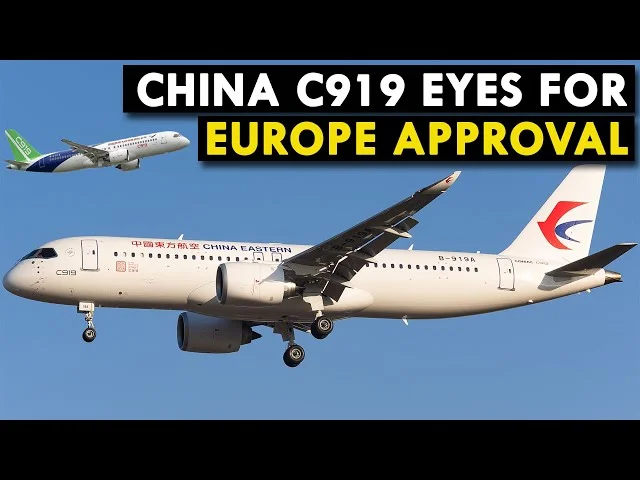Aviation
China seeks European approval of C919

In a strategic move to bolster the global standing of its domestically manufactured narrowbody passenger jet, the C919, China has announced plans to seek certification for the aircraft in Europe this year.
The Civil Aviation Administration of China (CAAC) conveyed this initiative during its annual industry working conference in Beijing. The objective is to enhance the international recognition of the C919 and position it as a formidable competitor against industry giants Boeing and Airbus.
Chinese government officials emphasize active collaboration with international aviation authorities, specifically the Federal Aviation Administration (FAA) and the European Union Aviation Safety Agency (EASA), in securing the necessary certifications for the C919. Such internationally recognized airworthiness certification is not only crucial for exporting Comac’s aircraft but is also integral for establishing global acceptance of Chinese commercial aerospace manufacturing.
The C919 program achieved notable milestones recently, including its inaugural flight outside Mainland China, where it demonstrated its capabilities with a flight over downtown Hong Kong in December. China Eastern Airlines, based in Shanghai, also confirmed the receipt of its fourth C919 jet on Tuesday, underlining the momentum of the program.
Comac, the state-owned manufacturer behind the C919, is not only focusing on European certification but is also collaborating with Tibet Airlines to develop a high-altitude variant of the aircraft. Additionally, hints of a stretched variant being in the works indicate the manufacturer’s commitment to expanding the C919’s capabilities.
Despite these advancements, gaining foreign certification for the C919 represents a symbolic victory for China’s aerospace ambitions. However, the aircraft faces significant challenges in competing on the international stage with established players like Airbus and Boeing. Issues related to efficiency, maintenance, infrastructure, and geopolitical considerations present formidable hurdles. As a result, even with regulatory approval, the C919 is anticipated to encounter difficulties in securing orders beyond China and its allied nations.

Aviation
Boeing, Antonov to Collaborate on Defense Projects

– MOU represents Boeing’s commitment to work with Ukrainian industry
– Includes exploring opportunities for collaborating on in-country support of Unmanned Aerial Systems
A Memorandum of Understanding was signed today by Boeing and Antonov Company to investigate potential collaboration on defense-related projects.
“We’re happy to keep collaborating with the Antonov Company to help Ukraine’s economic development and expansion,” stated Ted Colbert, CEO and president of Boeing Defence, Space, & Security.
Airbus and the Antonov An-225: The Best Partnership:Click here
“This agreement demonstrates our ongoing efforts to find more opportunities to work with Ukrainian industry, which was underscored by our signing of the Ukrainian Defence Industry Compact earlier this year.”
The areas of potential collaboration identified in the agreement consist of training, logistical support and overhaul services for tactical Unmanned Aerial Systems utilized by the Ukrainian Armed Forces, which includes the ScanEagle. In addition, the companies will also explore opportunities for Antonov to provide engineering support to Boeing.
The six largest cargo aircraft ever built in the aviation industry:Click here
“A strong, innovative, and efficient defense industry is key to sustainable economic development and national security, and we are extremely excited to collaborate with Boeing,” said Ievhen Gavrylov, CEO of Antonov Company.
This agreement brings a whole new level of opportunity to implement the latest and most effective solutions – in addition to the possibility of future projects with Boeing in the aerospace and defense industry.”
-

 Travel1 week ago
Travel1 week agoAir India to Expand US Operations with Three New Routes After a Decade
-

 Travel2 weeks ago
Travel2 weeks agoWhy We Should Avoid These Stamps in a Passport
-

 Airlines1 month ago
Airlines1 month agoInvestigations Reveal Fake Chinese Titanium in Boeing and Airbus Jets
-

 Tech4 weeks ago
Tech4 weeks agoChina’s CATL Plans 1,800-Mile Electric Plane Launch by 2027
-

 Airport3 days ago
Airport3 days agoTop 10 Largest Airports in the World by Size
-

 Aerospace4 weeks ago
Aerospace4 weeks agoChina’s Fighter Jets Turn Wings into Autonomous Drones
-

 Airlines4 days ago
Airlines4 days agoAir India Rolls Out A350s for Delhi-New York JFK and Newark Routes
-

 Defence3 weeks ago
Defence3 weeks agoBoeing Enhances Chinook with New Engines and Block II Upgrades at $96 Million







